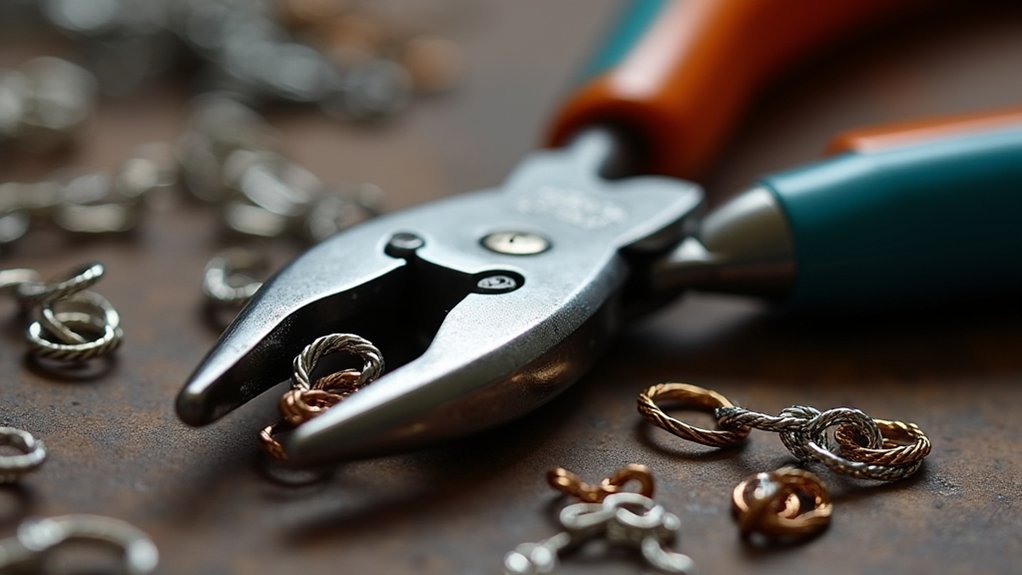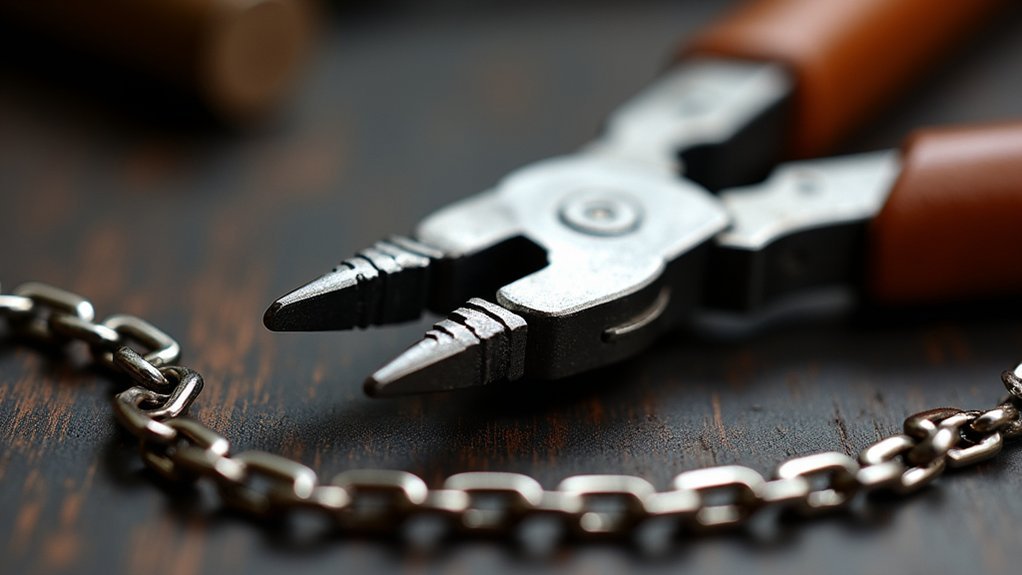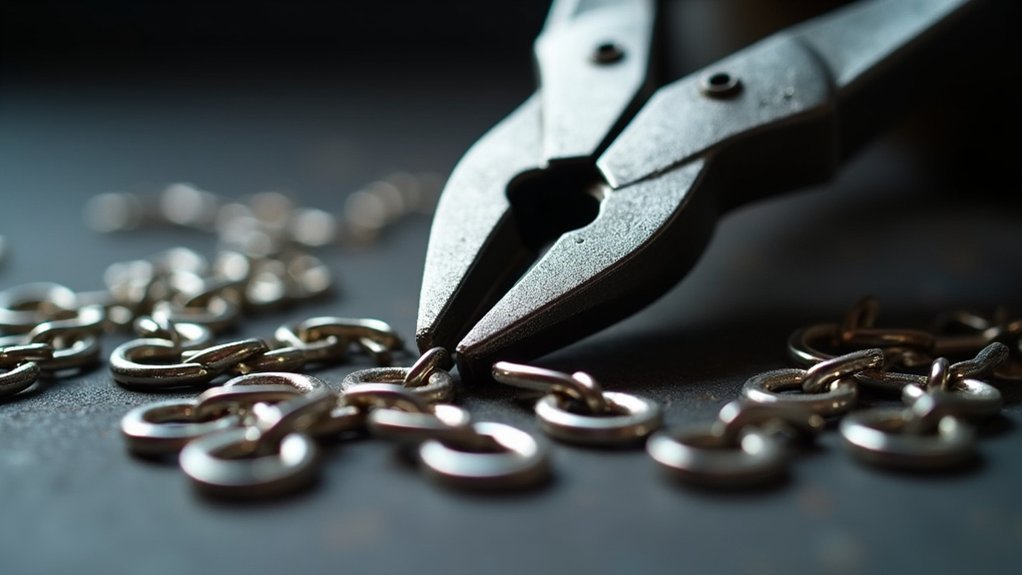You’ll need five essential plier types to create professional jewelry chains: chain nose pliers for precision wire bending, round nose pliers for forming consistent loops, flat nose pliers for gripping larger surfaces, side cutters for clean wire trimming, and specialty crimping pliers for professional finishes. Each plier serves specific functions depending on your chain style—cable chains require flat and round nose combinations, while complex rope chains need your complete toolkit. Master these fundamental tools and discover advanced techniques that’ll elevate your chainmaking craftsmanship.
Essential Chain Making Plier Types and Their Applications

When you’re starting a chain making project, selecting the right pliers becomes the foundation of your success. Each tool serves a specific purpose that directly impacts your finished piece’s quality and appearance.
Chain nose pliers are your go-to tool for gripping and bending wire with precision. You’ll rely on them constantly for opening and closing jump rings, making them indispensable for assembly work.
Chain nose pliers deliver the precision grip you need for flawless jump ring manipulation and wire bending in every project.
Round nose pliers excel at forming loops and curves, allowing you to create consistent links and smooth connections throughout your design.
Flat nose pliers offer superior grip strength for manipulating larger surfaces and shaping substantial wire sections.
Side cutters handle all your trimming needs, cleanly cutting through metal wire and jewelry string.
Specialty options like magical crimping pliers elevate your work by delivering professional-grade finishes to crimped connections.
Selecting the Right Pliers for Different Chain Styles
Different chain styles demand specific plier combinations to achieve their distinctive characteristics and structural integrity. Your plier selection directly impacts the quality and appearance of your finished jewelry piece.
| Chain Style | Primary Pliers | Secondary Tools |
|---|---|---|
| Cable Chain | Flat nose, round nose | Snipe nose for jump rings |
| Byzantine | Flat nose for gripping | Round nose for loop formation |
| Box Chain | Snipe nose for precision | Specialty crimping pliers |
| Figaro | Round nose for varied loops | Flat nose for stabilization |
| Rope Chain | Multi-tool set recommended | All plier types needed |
Complex designs like rope chains require thorough tool sets, while simpler cable chains need just flat nose and round nose pliers. Match your plier selection to your chain’s complexity for ideal results.
Wire Manipulation Techniques for Perfect Link Formation

Mastering wire manipulation starts with understanding how each plier type creates specific link formations in your chain-making process.
Round nose pliers are your go-to tool for forming consistent loops that’ll become the foundation of each chain link. You’ll grip the wire at the tip and roll it around the jaw to create uniform circles.
Master consistent loop formation by gripping wire at the plier tip and rolling around the jaw for uniform circles.
Flat nose pliers excel at making sharp bends and gripping sections during wire wrapping techniques. Use them to create angular connections between links with precision control.
Snipe nose pliers handle delicate tasks like opening and closing jump rings without marring the metal surface.
Side cutters guarantee clean wire ends by trimming excess material flush. This prevents sharp edges that could weaken connections or scratch skin, maintaining both safety and professional appearance in your finished chains.
Maintaining Your Chain Making Pliers for Longevity
Perfect chain making starts with quality tools, but your pliers won’t maintain their precision without proper care. Regular cleaning with a soft cloth removes dirt and debris that can compromise your making pliers’ effectiveness and cause rusting.
Every few months, apply a drop of machine oil to the pivot joint for smooth operation and reduced wear on moving parts.
Store your pliers in a protective case to prevent damage from drops or contact with other tools, which can misalign the nose and jaws.
Inspect the jaws regularly for wear or damage, as compromised surfaces affect precision and results.
Use your pliers only for intended purposes like wire wrapping and chain link removal to prevent unnecessary strain and extend their lifespan.
Professional Tips for Achieving Seamless Chain Connections

While maintaining your pliers guarantees they’ll perform reliably, achieving truly seamless chain connections requires mastering specific techniques that separate amateur work from professional results. You’ll want to use round nose pliers for consistent loop creation, ensuring uniform sizing throughout your chain. When working with jump rings, needle nose pliers provide the precision needed to open and close links while maintaining their structural integrity.
| Plier Type | Primary Function | Professional Tip |
|---|---|---|
| Round Nose | Loop Creation | Maintain consistent grip position for uniform loops |
| Flat Nose | Secure Gripping | Apply even pressure to prevent surface damage |
| Side Cutters | Clean Trimming | Cut at slight angle for flush finish |
For medium bail making projects, combine these techniques with high-quality stainless steel pliers to achieve professional-grade results consistently.
Frequently Asked Questions
Can Chain Making Pliers Be Used for Other Jewelry Making Tasks?
You can definitely use these pliers for various jewelry tasks beyond their primary purpose. They’re excellent for opening jump rings, adjusting wire loops, holding small components, and general metalwork requiring precise grip control.
What’s the Typical Price Range for Quality Chain Making Pliers?
You’ll typically spend $15-40 for decent quality pliers, while professional-grade options range $50-150. Budget tools work for beginners, but investing in mid-range pliers around $30-60 offers better durability and precision.
Are Left-Handed Chain Making Pliers Available for Purchase?
You’ll find left-handed chain making pliers from several manufacturers. They’re designed with reversed jaw angles and handle orientations. You can purchase them through specialized jewelry supply companies, though they’re less common than right-handed versions.
How Do I Know When to Replace My Chain Making Pliers?
You’ll know it’s time when your pliers won’t close properly, show visible wear on jaws, create inconsistent links, or require excessive force. Replace them if they’re damaging wire or producing poor-quality connections consistently.
Can Beginners Use the Same Pliers as Professional Jewelers?
You can absolutely use professional-grade pliers as a beginner, but you’ll pay more for features you might not need yet. Start with quality mid-range tools that’ll grow with your skills.
In Summary
You’ve now got the knowledge to create flawless chains with the right pliers and techniques. Remember to choose tools that match your chain style, practice proper wire manipulation, and maintain your pliers regularly. Don’t rush the process—perfect links take patience and precision. Keep experimenting with different approaches until you find what works best for your projects. Your chains will improve dramatically with consistent practice and attention to detail.





Leave a Reply